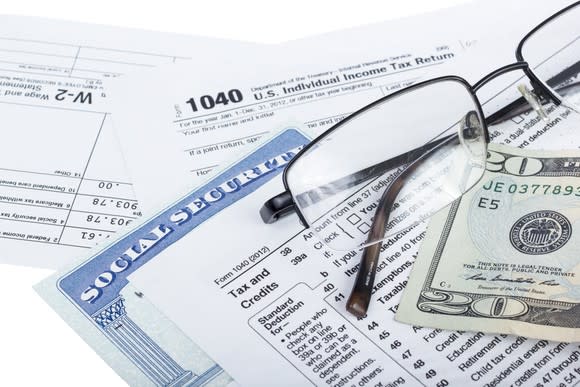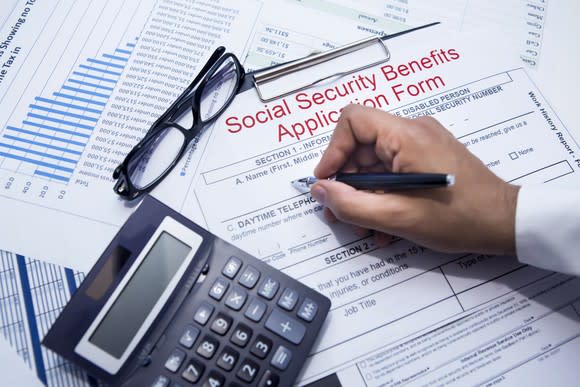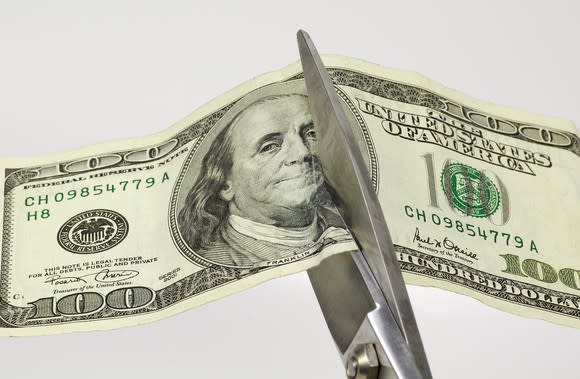10 Things to Know About Social Security Before You Retire

Image source: Getty Images.
Social Security is, for tens of millions of Americans, an indispensable financial foundation. As of August, more than 42 million seniors were receiving a monthly stipend from the Social Security Administration (SSA), with 62% of these seniors counting on their check for at least half of their monthly income.
Yet despite how vital this social program is, knowledge of the ins and outs of Social Security is often lacking. Back in 2015, just 28% of the 1,500-plus people who took MassMutual's 10-question true-or-false quiz on Social Security got a passing grade, defined as seven or more answers correct. Only one person managed a perfect score. Put plainly, what you don't know about Social Security could cost you dearly once you retire.
With that in mind, let's have a look at 10 important things you should know about Social Security before you retire.

Image source: Getty Images.
1. How you'll be paid
Without question, the most important thing you'll want to know is how your benefit is calculated. There are actually four factors that determine your monthly benefit, three of which you can control: your work history, your earnings history, and the age at which you file.
When calculating your payout, the SSA takes into account the income you earned in your 35 highest-earning years. This is why it's important, should you want to maximize your payout, to work for at least 35 years, if not more. Each year less of 35 worked causes a $0 to be averaged into your annual earnings history, which will lower your ultimate payout.
The age at which you sign up for benefits matters, too -- we'll discuss that in greater detail in the next point. The key here is understanding that you can begin taking benefits at age 62 or any age thereafter, and that the longer you wait to begin taking Social Security benefits, the bigger your benefit will be. Benefits grow by 8% annually beginning at age 62 and up until age 70.

Image source: Getty Images.
2. Your full retirement age
The fourth factor that helps determine your payout is your birth year, which you have no control over. Your full retirement age (FRA), or the age at which the SSA deems you eligible to receive 100% of your monthly benefit, is tied to your birth year.
In simple terms, if you sign up for benefits at any point between age 62 and one month prior to your FRA, you'll accept a permanent reduction in your payout of up to 30%. If, however, you file any time between one month after your FRA and age 70, you'll actually receive more than the 100% you'd get at your FRA. In fact, depending on your birth year, your "bonus" could be up to 32% more if you wait until your benefit maxes out at age 70.

Image source: Getty Images.
3. Your estimated monthly payout
Once you know your full retirement age, and you have a grasp on the factors that can impact your payout, it's time to dig in and find out what your estimated monthly benefit will be. While the SSA provides a paper statement to workers listing their estimated monthly benefit at full retirement age once every five years, you can check your estimated retirement benefit at any time using the SSA's various online estimating calculators.
Depending on how precise of an estimate you'd like, you can either use the SSA's quick calculator to get a rough estimate of your monthly payout or enter more information into its detailed calculator or retirement estimator to get a more precise estimate of your payout. As you might imagine, the closer you get to retirement, the more accurate the SSA's estimate will be.

Image source: Getty Images.
4. The percentage of wages Social Security actually replaces
Next, it's time to come to terms with the fact that Social Security isn't designed to be your retirement "plan A." In fact, the SSA suggests that the average worker should only expect their benefits to replace about 40% of their working wages. Lower-income folks could see this figure jump above 50%, while the well-to-do may see it dip below 25%, but the point is that Social Security was never designed to be a primary source of income during retirement.
Nonetheless, current data shows that better than three in five retired workers lean on Social Security for half their monthly income, and a third rely on it for 90% or more of their income.

Image source: Getty Images.
5. Social Security's purchasing power has been falling for a while
You should also understand that your Social Security dollars probably won't keep up with inflation over the long run. Even though Social Security benefits are tethered to inflation as measured by the Consumer Price Index for Urban Wage Earners and Clerical Workers (CPI-W), this index hasn't adequately accounted for the medical care and housing inflation that seniors have faced in recent years. According to an analysis from The Senior Citizens League, Social Security dollars have lost 30% of their purchasing power just since the year 2000.
Additionally, in 33 of the past 35 years, Social Security's annual cost-of-living adjustment (the annual raise given to beneficiaries) has been smaller on a percentage basis than the medical care inflation rate.

Image source: Getty Images.
6. You'll probably have to pay federal income tax on your benefits
More bad news: Not only are your Social Security dollars liable to lose purchasing power over time, but you also have a better chance than not of owing federal income tax on a portion of your Social Security benefits.
In 1983, amendments passed by Congress allowed individuals earning more than $25,000 annually, and couples filing jointly earning more than $32,000, to have half of their Social Security benefits exposed to the federal ordinary income tax. In 1993, the Clinton administration added another tier that allows up to 85% of benefits to be taxed at the ordinary rate for individuals and couples filing jointly who earn more than $34,000 and $44,000 a year, respectively. These income thresholds have never been adjusted for inflation, meaning a tax that once affected about one in 10 households receiving benefits now impacts 56% as of 2015, per The Senior Citizens League.

Image source: Getty Images.
7. How the earnings test can impact early filers
If you're thinking about claiming Social Security early and continuing to work at the same time, even for just a few extra years, you'll want to understand how the earnings test could affect what you'll bring home.
The earnings test applies to filers who haven't yet reached full retirement age. In 2017, individuals who won't reach their FRA could see $1 in benefits withheld for each $2 in earned income above the annual limit of $16,920. If you'll hit your FRA in 2017, but haven't yet done so, then $1 in benefits can be withheld for each $3 you earn above an annual limit of $44,880, until you reach your FRA.
The good news is you don't entirely lose any benefits that are withheld. They're given back to you in the form of a higher monthly payment once you hit your full retirement age. However, if you're looking to double-dip and boost your income between age 62 and your full retirement age by receiving both earned income and a Social Security check, you may want to think again.

Image source: Getty Images.
8. Your claim may affect your spouse or family
It's also important to realize that your claiming decision may not be all about you. If you're married or have young children, the age at which you file could directly affect what they can receive in survivor benefits should you pass away. This is particularly important for households in which one spouse earned significantly more than the other over their lifetime. A higher-earning spouse who waits until full retirement age or later to claim benefits and passes away first may give their lower-earning spouse a means to claim a higher survivor benefit.
Along those lines, couples should make a game plan to maximize their household payout during retirement. Though it will depend on your financial situation, higher-income spouses often benefit most by waiting to enroll.

Image source: Getty Images.
9. There is a mulligan available
You should also understand that you have options even after you've begun receiving benefits. The SSA actually has a "mulligan" built in that allows early filers, or those who regret taking benefits, to potentially undo their claim.
SSA Form 521, officially known as the Request for Withdrawal of Application, allows you to pay back every cent you've received from the SSA in exchange for undoing your claim and restoring your benefits to 8% growth a year until age 70. The catch? You only have 12 months after you begin receiving benefits to file Form 521.
This do-over is particularly useful if you've filed for benefits because you were having trouble finding a job and generating income, but later wind up landing a well-paying job a few months later.

Image source: Getty Images.
10. Benefit cuts may be looming
Last, but certainly not least, you should be aware that Social Security's future is up in the air. While the program won't go bankrupt (payroll tax revenue on earned income ensures that can't happen), the current payout schedule doesn't appear sustainable.
According to the Social Security Board of Trustees' 2017 report, the program's $3 trillion in asset reserves is expected to be completely exhausted by 2034, leading to a projected $12.5 trillion shortfall between 2034 and 2091. If Congress is unable to find a way to generate more revenue, the Trustees believe that up to a 23% across-the-board cut in benefits may be needed to sustain payouts through 2091.
In other words, you should be prepared for the possibility of a cut to your benefits within the next two decades. This, along with Social Security benefits' declining purchasing power, is all the more reason to ensure that Social Security is a supplementary source of income and not your Plan A.
More From The Motley Fool
Why You're Smart to Buy Shopify Inc. (US) -- Despite Citron's Report
6 Years Later, 6 Charts That Show How Far Apple, Inc. Has Come Since Steve Jobs' Passing
NVIDIA Scores 2 Drone Wins -- Including the AI for an E-Commerce Giant's Delivery Drones
The Motley Fool has a disclosure policy.
